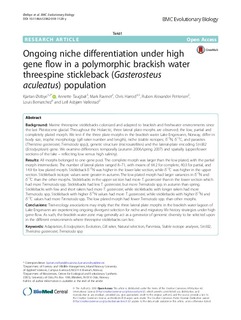| dc.description.abstract | Background: Marine threespine sticklebacks colonized and adapted to brackish and freshwater environments since the last Pleistocene glacial. Throughout the Holarctic, three lateral plate morphs are observed; the low, partial and completely plated morph. We test if the three plate morphs in the brackish water Lake Engervann, Norway, differ in body size, trophic morphology (gill raker number and length), niche (stable isotopes; δ15N, δ13C, and parasites (Theristina gasterostei, Trematoda spp.)), genetic structure (microsatellites) and the lateral-plate encoding Stn382 (Ectodysplasin) gene. We examine differences temporally (autumn 2006/spring 2007) and spatially (upper/lower sections of the lake – reflecting low versus high salinity). Results: All morphs belonged to one gene pool. The complete morph was larger than the low plated, with the partial morph intermediate. The number of lateral plates ranged 8–71, with means of 64.2 for complete, 40.3 for partial, and 14.9 for low plated morph. Stickleback δ15N was higher in the lower lake section, while δ13C was higher in the upper section. Stickleback isotopic values were greater in autumn. The low plated morph had larger variances in δ15N and δ13C than the other morphs. Sticklebacks in the upper section had more T. gasterostei than in the lower section which had more Trematoda spp. Sticklebacks had less T. gasterostei, but more Trematoda spp. in autumn than spring. Sticklebacks with few and short rakers had more T. gasterostei, while sticklebacks with longer rakers had more Trematoda. spp. Stickleback with higher δ15N values had more T. gasterostei, while sticklebacks with higher δ15N and δ13C values had more Trematoda spp. The low plated morph had fewer Trematoda spp. than other morphs. Conclusions: Trait-ecology associations may imply that the three lateral plate morphs in the brackish water lagoon of Lake Engervann are experiencing ongoing divergent selection for niche and migratory life history strategies under high gene flow. As such, the brackish water zone may generally act as a generator of genomic diversity to be selected upon in the different environments where threespine sticklebacks can live. Adaptation, Ectodysplasin, Evolution, Gill raker, Natural selection, Panmixia, Stable isotope analyses, Stn382, Theristina gasterostei, Trematoda spp | |
